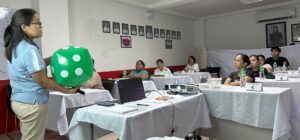MANILA – IRRI’s head of security, Glenn Enriquez, was invited to speak at an International Film Expo in Manila earlier this month. His talk showcased the work done by the Institute’s security team and focused on the Unmanned Aerial Systems (UAS), more commonly known as drones, which patrol the campus of over 200 hectares, 6 times a day.
The drones are complementary measures to the ground patrol team. Warlito Untalan, UAS team leader, has conducted 1,020 flights, equivalent to 340 hours. “Introduced in 2012, the drones are used in a complementary capacity to the ground team,” Mr. Enriquez said. “If one of our ‘pilots’ operating the drones spots any unusual activity, they call the ground team to check on the situation. In the past cows have been spotted grazing on the rice fields at night, which could affect the scientists’ experiments, and may not have been detected without the use of drones equipped with thermal imaging cameras.”
Drones are also a useful tool for scientists, who can see their rice experiments from a bird’s eye view. This can help for research purposes, such as the comprehensive assessment of complex plant traits such as growth, development, tolerance, yield and other observable traits. However, there are many future exciting prospects for the drones, and James Quilty, head of IRRI’s experiment station says, “There is little doubt that in the future, drones will be involved in a wide range of tasks from phenotyping, possibly sampling, and probably delivering payloads to plots. The technology is advancing rapidly.”
Steve Klassen, an environmental science and engineering consultant at IRRI, uses drones to check on his 5 hectare plot. The drone must be flown 3 times with 3 different cameras in order to collect the necessary information, taking about 30 minutes. Without drones, this process would take around 4 hours. “This season, drones will be tested alongside more traditional data-collection methods to evaluate their performance and potential,” he said.
IRRI’s use of drones aligns with good practices regarding privacy. “Respect for privacy is paramount in the operations of the drones,” Mr. Enriquez emphasized. “For this reason, IRRI’s security team works very closely with the local community to inform them of the reasons we use drones. Also, the drones are not flown above the local communities, as can be shown by the GPS-tracked flight paths.”
Any publicly posted video or photographic materials taken by the drones can be used freely under a creative commons license, which includes attribution to IRRI.
The 2015 International Film Expo was held on 26-28 June at the SMX Convention Center.
Posted by: Sophie Anderson









